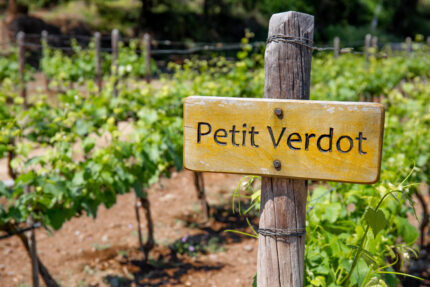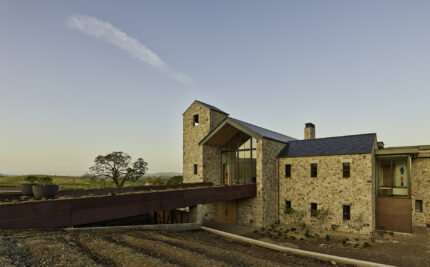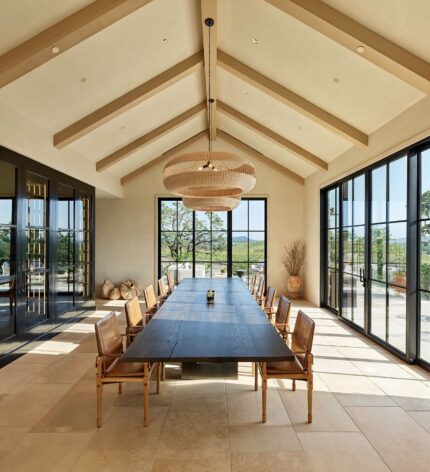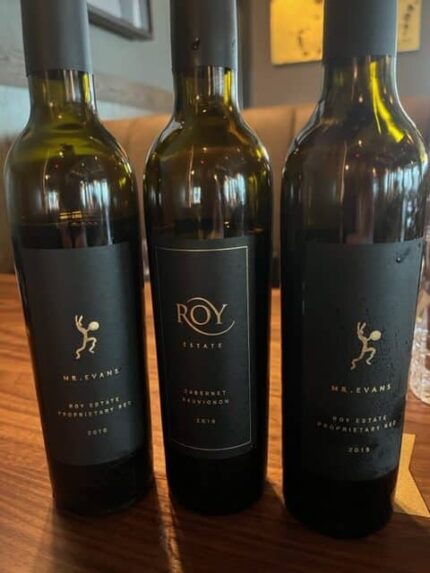I had the chance to interview Bryan Zupon, the estate manager at Roy Estate, a distinguished Napa winery recognized for its seamless integration of Old World and New World winemaking methods. Roy Estate has garnered praise for introducing the concept of Bordeaux terroir to California, a distinction credited to the distinctive landscape shaped by a creek dividing the property. This unique feature creates varied environments for grape cultivation, mirroring the topography found in France.
Within those 17 acres, a compelling argument can be made for the profound influence of terroir. A creek divides the parcel roughly in half, producing two distinct sites on one small estate. The geography, topography, microclimates, and soil exhibit significant variations even from such a small parcel of land. On one side, classic volcanic soil produces smaller, low-yielding vines that generate wines with powerful tannins. The other side produces deeper, more loamy soils supporting bigger and stronger vines that bear more profound and layered wines.
Situated to the south of the Stags Leap District, this land occupies the cooler, southern extremity of Napa Valley, positioned right at the base of Atlas Peak.
But let’s start with the story of Roy Estate.
Originally, the property belonged to Johnny Miller, a Hall of Fame PGA golfer and NBC golf commentator. As a Mormon, Johnny abstained from consuming wine. Instead, he cultivated grapes and utilized the land for farming purposes.

Shirley and Charles Roy purchased the land with the original intent to build a home overlooking the vineyards. In 1999, renowned Winemaker Helen Turley convinced them they had an exceptional property and to plant Cabernet Sauvignon, Merlot, and Petit Verdot. Adding Petit Verdot as a blending varietal became a part of her viniculture legacy. One site was on the hillside with its thin, lava-covered soil, dedicated to Cabernet planting, while the other was planted in the deeper soil with richer loam, with a focus on Merlot.
In 2005, the winemaker Philippe Melka joined the team at Roy Estate. Bryan characterized him by stating, “You can take the man out of Bordeaux, but you can’t take the Bordeaux out of the man.” With his French background and extensive experience in Napa wines, Melka became the ideal collaborator to craft what Roy Estate refers to as the “Grand Cru de Napa Valley.” Given Melka’s analogy between the winery’s Stags Leap District Cabernet vineyards and those of the Médoc, Roy Estate aspires to be likened to a Bordeaux First Growth.
In 2010, Charles passed away and Shirley took over the reins of the company for the next seven years. In 2017, Roy Estate was sold to Canadian businessman and entrepreneur Stéphan and his wife, Stéphany Crétier, ironically after they first stopped by for a wine tasting. They shared Melka’s commitment to single vineyard, estate-grown Grand Crus from the Napa Valley.
However, the ink barely had time to dry on the contract before the Atlas fire struck. The good news is that the vines were preserved, but the structure was destroyed.


Bryan noted this was the perfect opportunity to ‘experiment and reimagine’ historic plantings and construction of state-of-art production facilities. The team came up with the concept of La Résidence, a multi-functional place that incorporates the family home, a hospitality space, and a new tank room. He talked about the process of getting it finished – an estimated year and a half that turned into over four and a half years. But it was our duty to “build a truly great place and it became a defining moment for the winery.”
The Pivot Point
Wine critic Robert Parker first unveiled Roy Estate to the world by calling them a “hidden gem” of the New World. Since then, they have sold their 1,500 cases via allocation and winery visits are referral only. The wines are sold in Singapore, Hong Kong, Dubai, Japan, Korea, Singapore, the United States, Northern Europe, and the UK.
Today and the Future
Bryan talked about how farming is approached today as a vital ecosystem and the winery is moving toward incorporating more organic processes to make sure the soil is healthy. “Since the fires, we put a lot of research to make sure the soil is healthy – from genome sequencing of the soil to looking at the entire journey of that wine starts and stops in this place.”
We talked about the future. Currently, they are planting Cabernet Franc in some of the highest places and are looking toward producing a white in 2029. It’s still a story of Bordeaux varietals and making them the best they can be. Bryan said, “It’s been a five-and-a-half-year journey on determining the vinicultural site destiny of Roy Estate.”

The Wines (Delicious)
2015 Roy Estate Mr. Evans Proprietary Red – it was fun to benchmark two wines over time and see the difference. This side of the estate has spongy loamy soil, and the winery describes it as adding energy and fertility. I tasted cassis, blackberries, blueberries, violets, earth, menthol, cedar, and smoked meat.
2019 Roy Estate Mr. Evans Proprietary Red – This was an energetic, smooth wine that lingered on the palate. In this wine, I tasted blackberry jam, red fruit, fennel, graphite and licorice, fennel, wildflowers, menthol, and violets. Two very different wines from the same place, but different years that showed the difference.
2019 Roy Estate Cabernet Sauvignon – From the volcanic side of the estate, this is a powerful wine. This part of the vineyard features smaller berries, and I tasted blue and black fruit, herbs, cocoa powder, mocha, and graphite.
Roy Estate blends tradition and innovation through its distinctive landscape, shaped by a dividing creek, creating an environment fostering diverse grape cultivation. Within the 17 acres, the profound influence of terroir is evident, as the creek divides the estate, giving rise to two distinct sites capable of producing a Napa version of a Grand Cru. The rich interplay of geography, topography, microclimates, and soil within this small parcel underscores the estate’s commitment to showcasing the nuanced and varied expressions of terroir in such a small place.



